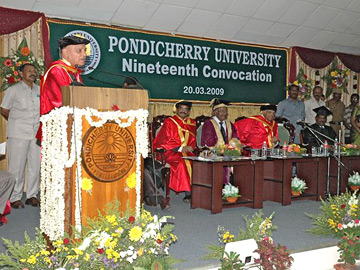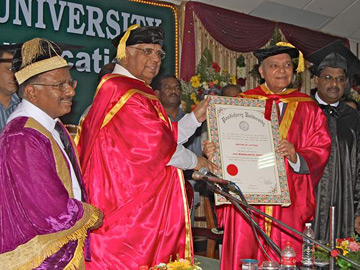Award of Degree of Doctor of Letters (Honoris Causa)
to Shri Madanjeet Singh, UNESCO Goodwill Ambassador & Founder SAF
 |
 |
|
| Speaking from the left: Shri Madanjeet Singh, UNESCO Goodwill Ambassador & Founder South Asia Foundation, Seated from the left: Shri Mylswamy Annadurai, Project Director of Chandrayaan-1; Pondicherry University's Vice Chacellor, Dr J.K.A.Tareen; Shri Somnath Chaterjee, Honorable speaker of Lok Sabha. |
Shri Madanjeet Singh, UNESCO Goodwill Ambassador & Founder South Asia Foundation receiving the Diploma of Degree of Doctor of Letters (honoris causa) (third from left) from he hands of Shri Somnath Chaterjee, Honorable speaker of Lok Sabha,in presence of Pondicherry University's Vice Chacellor, Dr J.K.A.Tareen. |
Citation by the University of Pondicherry on confirment of the Degree of Doctor of Letters (Honoris Causa) on Madanjeet Singh, UNESCO Goodwill Ambassador
Pondicherry: 20th March 2009
Originally hailing from Kashmiri ancestors, Madanjeet Singh was born at his maternal grandfather Makhan Singh’s joint family haveli in Lahore, in present-day Pakistan, on 16 April 1924. A well-known photographer and painter, he is the internationally known author of several books on art and other subjects, published worldwide in several languages. His latest book, Kashmiriyat, published under the patronage of UNESCO Cultural Sector, Paris, narrates how the secular South Asian pluralist cultures transcend religions.
Admitted to a primary-secondary school at the Hindu University in Benares, where his father Dogar Singh was a professor, Madanjeet became aware of India’s unity in diversity as his teachers came from different parts of the country. These multicultural notions were strengthened as he went to the southern edge of India and joined high school in Trivandrum, as his father was commissioned in 1936 to build a ceramic factory in the princely state of Travancore. Here Madanjeet became conscious of India’s rapidly growing opposition to colonial rule led by Mahatma Gandhi and Jawaharlal Nehru.
An agonizing period of Madanjeet’s tumultuous ordeal began in 1942, soon after he returned to Benares and joined the engineering college at the Hindu University, when Mahatma Gandhi launched the ‘Quit India’ movement. The young man was arrested along with other student activists, incarcerated in Mizapur jail for nine months, expelled from the province of UP, and moved to Lahore. There he was admitted to the Government College and, while he succeeded in obtaining a Master’s degree from the Institute of Honours School in Chemistry, his painful ordeal intensified in the wake of India’s Partition.
With a heavy heart and with tears in his eyes, Madanjeet was obliged to leave his beloved Lahore, a cosmopolitan city known as the ‘Paris of the Orient’, that communal monsters had torn apart with their bloody claws. At Amritsar railway station, he was horrified to witness a train arriving from Batala, blood dripping from the crevices under the doors of compartments full of dead and wounded passengers: a mob at Sharifpura had attacked the passengers with knifes, hatchets, and stones. Women had been stripped naked and one woman lay dead with a crying baby in her arms, one hand still gripping the door handle in an attempt to escape. As he describes in his book, The White Horse (on which Pandit Nehru rode in Lahore in December 1929, to proclaim India’s Purna swaraj), ‘I was stunned, a buzzing noise in my head drowned the wails and screams of the frightened men, women and children as they madly scrambled out of the train’s blood-soaked compartments.’
The trail of blood followed him to Delhi. Coming out of the railway station, he saw once again, as in Amritsar, blood dripping from a truck loaded with dead bodies —gruesome images that have ever since haunted him and ate into his soul. He volunteered to work in the Dewan Hall refugee camp facing the Red Fort in Delhi and organized a series of ‘Peace Campaign’ exhibitions of his photographs, as he had earlier shown in Lahore — a Herculean effort recognized by Prime Minister Jawaharlal Nehru who very kindly became Madanjeet’s mentor. Pandit Nehru handwrote a full-page preface to the collection of his photographs, This My People (1949), and recommended a scholarship offered by the Italian Institute of Middle and Far East (ISMEO) in Rome.
Madanjeet’s Italian sojourn in the early fifties turned out to be most creative and productive. He edited ISMEO’s quarterly journal, East and West, and supported by its director, Prof. Giuseppe Tucci, published his first book, Indian Sculptures in Bronze and Stone (1951). He worked part time at Italian Radio to broadcast daily news and views in Hindi; attended courses in European art history at the University of Rome; and continued to paint and participate in a number of art exhibitions. India’s Ambassador, impressed by his talents, employed him and as a cultural attach� Madanjeet launched a quarterly magazine, INDIA, in English, Italian, and Serbo-Croat (as the Indian Embassy was concurrently accredited to Yugoslavia). This magazine, dealing with Indian art and culture, was later printed in French and Russian as well. In 1954, Pandit Jawaharlal Nehru wrote another introduction to his book, INDIA, Paintings from the Ajanta Caves, published by UNESCO in its World Art series.
Joining the Indian Foreign Service in 1953, Madanjeet Singh continued painting. He published a number of books during his diplomatic career as Ambassador in Asia, South America, Africa, and Europe. Himalayan Art (1968), reviewed in a three-page article by TIME magazine, has since become a classic.
In 1982, Madanjeet Singh joined UNESCO as a director and was based in Paris. Following extensive Silk Route expeditions together with several eminent Asian scholars, he compiled the volume, The Sun in Myth and Art (1993). In association with another project on solar energy launched during the Solar Summit in Harare, Zimbabve, he produced two equally outstanding publications, Renewable Energy of the Sun (1996), and The Timeless Enegry of the Sun (1998). The 52-member UNESCO Executive Board at its meetings in Paris and Fez (16 May to 4 June 1995) established the biennial ‘UNESCO-Madanjeet Singh Prize for the Promotion of Tolerance and Non-Violence,’ marking the 125th birth anniversary of Mahatma Gandhi. In 2000, Madanjeet Singh was designated as a UNESCO Goodwill Ambassador on the United Nations’ International Day of Tolerance.
At present, Madanjeet Singh, aged 85, is devoting all his time and energy to the two foundations he established to promote his lifelong ideals and vision. Sumitra Foundation (1995), named after his mother and chaired by Dr. Manmohan Singh, is devoted to family planning and education. Later in 2000, he founded the South Asia Foundation (SAF), a secular, non-profit, and non-political organization, created to benefit the marginalized communities at the grassroots as well as higher education by establishing institutions of excellence in Afghanistan, Bangladesh, Bhutan, India, Maldives, Nepal, Pakistan and Sri Lanka. SAF has been admitted into an official relationship with UNESCO and recognized as an Apex Body of the South Asian Association of Regional Cooperation (SAARC). The aims, objectives, and activities of SAF are in conformity with the spirit, purpose, and principles of the two international organizations.
Madanjeet Singh’s book, The Sasia Story (2005), published by UNESCO in English, French, and Spanish as well as in 26 other language editions, is a riveting and poignant story of a young man’s activism and fervour and of the trauma he suffered during the fratricidal conflict in the wake of India’s senseless Partition. ‘Sasia’ is the name he has coined for South Asia’s common currency in the hope that, like the Euro, it will become the anchor of economic stability, regional cooperation, peace, and progress.













 Read more about "India"...
Read more about "India"... 